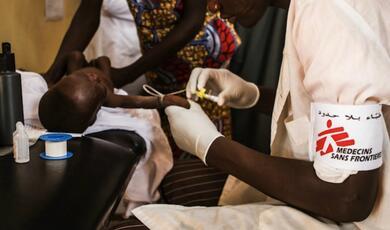27 January 2011
Enabling innovation and
improved performance in healthcare
Professor Bernard Crump
Thank you very much for inviting me. I hope that I am going to offer something to the group that is valuable to the topic of today, and I think I have found some ways in which it can be. I have been invited to talk about is how it is possible to enable innovation and improvement in healthcare, and, as Lord Warner said, I have been running the NHS Institute for Innovation and Improvement for the last five years.
Here is some context for healthcare. This is a graph taken from a very major report, from the King’s Fund and the Institute of Fiscal Studies, and it shows the funding of healthcare in the NHS since its inception in 1948, adjusting for inflation. You can see the really remarkable increase in both the absolute levels of funding and also the proportion of our Gross Domestic Product we have spent on healthcare over the period, from particularly 2000. We have had an extraordinarily generous increase in resources.
However, there was piece of work from the Office of National Statistics, discussing the outputs of the NHS. It is technically difficult to convert all of the activity of the health service; all of the beneficial healthcare outcomes; the quality of service and the impact on society from the health benefits of having a healthier population into a single number, which they call their outputs index. It showed from 1995 to 2008, a major increase in the outputs of the service – such as quality improvements – but it showed an even bigger increase in the inputs to the service. Resultantly, they concluded that the productivity of the service has, at best, been flat, and indeed, arguably, has fallen somewhat during this period of most dramatic increase in resources for the service.
Now, the work of the Institute, in part, is to seek to try and help make the service become more productive. The reason for the increased resources to the NHS was an argument that the NHS had fallen behind in its resources and needed more resources to keep up or to catch up. Indeed, during this period of time, there has been a 65% increase in the number of consultants working in the NHS which is an enormous increase in the workforce of the NHS. During this period of time, pretty much every single employee in the NHS has benefited from new contracts of employment, which have been more generous in many respects. The NHS is, in essence, a people business, spending roughly 70% of all of its costs on the workforce. Indeed, you could argue that it is almost impossible to create a situation where you improve productivity, in a time when you are also dramatically increasing the resources available to a service. However, we are going to see a change in the next few years, because we know that, back in 2009, Sir David Nicholson, the Nicholson challenge man, who is now going to be the Chief Exec of the new NHS Commissioning Board, rather bravely, made it very clear that the times of that dramatic increase in resources were bound to come to an end because of the fiscal situation. The NHS has been protected compared to social care, compared to many of the organisations that you may be interested in, and there is no doubt the NHS allocation for the next three to four years is much more generous than those of most other organisations.
Sir Derek Wanless was asked to look forward 20 years at the resources that the NHS would need to meet the needs and demands of our population. This slide shows that, each year, with the new allocation, a gap grows between what Sir Derek Wanless said the NHS would need in that year and what it will now get because of the new allocations. Sir Derek Wanless’ report had three different scenarios, but in essence, even in his most optimistic scenario, in which we all get more engaged in being interested about our health, and over 20 years, we reduce our lifestyle risks and the service becomes much better at operating in a more productive way, by 2014/15, there will be a gap of around £15 billion between what he said the NHS would need and what it will now get under the new funding. Under his most pessimistic scenario, the gap is £20 billion, and that is where this £15-20 billion figure comes from. It is not that £15-20 billion will be taken out of the budget of the NHS. The budget next year will be bigger than this year, and it will be bigger the following year, but it is that the needs and demands of an aging population, of new technologies, and of the expectations of our services, at least in Derek Wanless’ very detailed work, will grow at a rate faster than the resources will now grow, and that gap has to be filled.
Now, this is how the money moves round the current system. The Department of Health makes allocations, currently, to Primary Care Trusts, who pass that money on through a range of contracts, to hospitals, to community services, and indeed to fund general practice itself, and actually, the vast majority of that resource, as I said earlier on, ends up finding its way into the pay bill for the staff of the NHS or to the purchase of goods and services like drugs. Government currently, under the current system, can influence very many parts of this system. They can determine the rate of allocation, using the formula Gwyn was talking about earlier. They currently set the tariff, the arrangements that determine how much is paid to a hospital for a particular patient having a particular procedure. Currently, in our system, they do most of the pay bargaining, through central pay bargaining, and they have an influence on prices, not sometimes as much as they would hope to, and in a rather confused way, but particularly in relation to drugs, they have an influence on prices.
Government has been pulling those levers. The most potent lever that it has pulled is to introduce a pay freeze for the staff of the NHS for two years, and a further piece of work by the King’s Fund and the Institute of Fiscal Studies has suggested that the levers they have pulled may have meant that the challenge is now a bit smaller, perhaps in the region of £11-14 billion. Another way of putting that is that £11-14 billion has to be delivered through local improvements, in every part of the system, because the pulling of the central levers has generated about as much of an impact as it reasonably can.
I would say that there is good evidence, and I will show you some, that we can bring about purposeful, important improvements in quality; and some of it has happened at a very substantial pace and scale - the sort of pace and scale necessary to keep up with that growing gap between the resources we need and the resources we are going to get. However, there is much more limited evidence that these improvements in quality have translated into the release of cash, and in our system, some of the productivity improvement will have to be through the process of releasing real cash because that cash needs to be in a different part of the system than the organisation that produces the productivity improvement. Not all of the £11-14 billion, but a significant element will have to be cash-releasing, and the evidence that we have done that successfully in the past is very limited. Finally, sometimes, the mechanisms we have used to bring about these improvements in quality have had unanticipated consequences, some of which have been detrimental to healthcare.
Here are a few examples as to why I have reached those conclusions.
This rather busy slide shows every A&E Department in the country, the red dots, and the same organisations, the blue dots, six months apart, between October to December 2003 and April to June 2004, and it shows the proportion of patients who were seen and treated within four hours in their A&E Department. The x axis shows the percentage improvement in an individual organisation’s performance. It shows that there was a dramatic improvement in the proportion of patients seen within four hours, over only a six month period, through a combination of performance management and Ministers setting a target that had to be met. Also, the predecessor to my Institute, the Modernisation Agency, working with A&E Departments to implement a particular approach to seeing patients, called “See and Treat”, that had been developed and innovated in one hospital in Kettering and then gradually was moved across the whole NHS, so that the vast majority of organisations used it. However, as we all know, this improvement in hitting the target also had some unintended consequences, some poor clinical consequences, and some instances where organisations hit the target but missed the point which was that they needed to treat people quickly, but also clinically effectively.
This next slide is a rather better example, I hope. This shows, nine months apart, 19 NHS Trusts that worked with us at the Institute, and with one another, importantly, in order to implement some improvements in the care of patients, maternity patients, in order to try and reduce the Caesarean section rate, which has been very high. You will see the vast majority of these organisations, with a couple of exceptions, over that nine month period, made significant improvements in their Caesarean section rates, something which has been growing in the past and is notoriously difficult to change. Through working together, on strong, clinical evidence-based approaches, they learned how to carry out a service improvement, by using quality improvement methods from us and they also learned from one another, working collaboratively, how a problem that was intractable in one place had been solved in another.
This slide is from an article that came out in the BMJ last year. This is one Trust that implemented a range of specific quality improvements, called care bundles. A care bundle is a range of process measures. For example, if you are a patient who is in an Intensive Care Unit, you stand a chance, if you are on a ventilator, of getting pneumonia, but we know that there are six specific examples of clinical practice which, if completely reliably applied to every patient in that situation, in a consistent, reliable way, dramatically reduce the chance of that patient getting pneumonia. That would be a care bundle. This hospital implemented a range of those care bundles, and saw really rather dramatic improvements in their hospital standardised mortality ratio over only a year, via the application of these approaches. There are many other examples I could tell you.
Now, my Institute tries to support the NHS in finding ways of implementing these changes. A lot of the work that we do is finding good ideas in the Service, or in other healthcare systems in other parts of the world, Holland amongst them, or actually in completely different industries that many of you may have worked your life in, bringing those ideas to then work with frontline clinicians to see if those ideas can be adopted or adapted in a way that means that they can improve the quality of care in health services. I will show you some examples.
The institute is five years old. We were set up by Lord Warner and we have, for those five years, principally been funded by a grant from the Department of Health. Our work focuses on four main themes: the development of clinical leaders and also leaders of organisations; to understand how to lead for improvement; and on the right use of measurement for improvement. All of us, as clinicians, learned about measurement, statistics and research in our training, but we learned a particular branch of statistics which is about telling whether treatment A is better than treatment B, but actually, in improvement work, you need a different branch of statistics, which is telling whether the service today is better than the service was yesterday, and we have had to teach people a lot of that. We use some tried and tested tools and techniques of improvement, many of them borrowed and adapted from other industries, things that you may have heard of, like Lean thinking or the theory of constraints. We use a range of these, and, crucially, we work with organisations on trying to create the most effective relationships between members of teams within organisations or between one organisation and another. We like to describe what we do as about both the anatomy of trying to bring about improvement, by which we mean the measurement and the tools and the techniques, but also the physiology, which is the creation of a sense of engagement in this work, getting clinicians to lead this work, helping people to have more respectful relationships with one another, and bringing in patients and carers so that their expertise can be used in helping to bring about improvements.
We have applied this, over the five years, to things like improving how quickly people wait. We call our programme “No Delays” and we have helped lots of NHS organisations deliver on the dramatic improvements there have been for waiting in A&E, but also for elective care or in general practice. We have brought these approaches to how we can really make a reality of patient engagement. I will show you a case study based on this.
We have tried to help recognise that hospitals do 620 different things, at least, in our tariff system. There are 620 different payment points in the tariff, but 50 of those 620 make up 50% of all of the activity. So, if we got the high-volume, common things right, that would go an enormous way to improve our system. Therefore, we have worked on understanding how the organisations which are really excellent, both in the UK and in the rest of the world, manage those high-volume things.
We have looked at trying to find ways of helping frontline staff spot waste in the way that services are organised, and take steps, and own the steps, to change the system in order to take out that waste. We have been involved in trying to improve patient safety, building skills for improvement across the service, and also, in trying to ensure that change that often happens on a small scale can extend to happen on a much larger scale.
Finally, a big part of what we do has been trying to help organisations create a culture that is more conducive to innovation. Somebody mentioned earlier the high costs of research. The UK punches enormously above its weight as a small country in the world’s ideation around healthcare, in the part of innovation which is about finding the great initial ideas. There are countless examples of technologies now being used across the world that were thought up in the UK, and, speaking in the Royal Society, there is no better place to make that point. However, we are lousy at commercialising those great ideas within the UK and spreading them effectively and successively across the system so they are reliably delivered everywhere. We are trying to help create a culture that is more conducive to fostering innovation and spreading it.
I am going to give you two of many possible examples to try and put some flesh on the bones of what I have said and make it, hopefully, more understandable. I have hoped to choose examples which might be relevant to the aged care issue.
One of our programmes, the productive series, seeks to help frontline clinical staff to find waste and to be able to reorganise their services in a way that frees up time and resources so they can be spent on the right things and create productivity improvement.
The first place we started was the ward of an acute hospital. We worked with lots of hospitals, and we found that around 25% of a nurse’s time on duty in an acute hospital is spent in direct, meaningful patient care. The rest of the time is spent in things such as moving about, administration, discussion because there is a lack of clarity about what should happen, handovers, discussions due to lack of clarity about roles and finding information. We found that, by applying some of the principles that are used in other industries that are focused on things like Lean or Six Sigma, we were able to see successive reductions. We did not say that these things could work in healthcare as well as they work in Toyota, but we took those principles, worked with a group of frontline clinicians to see if they could adapt those principles to make them relevant to work on the wards. By ensuring that everything was kept in the right place, improving paperwork, avoiding the interruption of people who were doing safety-critical tasks, by making handovers more concise and timely, but even more importantly, by making it clear who was responsible for things, we could lead to a substantial improvement in the proportion of time that nurses spend in direct patient care. The typical results are that we will start with an organisation that, at baseline, is spending 25-30% of a nurse’s time in direct patient care, and after they have implemented these changes – and no two wards, even in the same hospital, adopt exactly the same solutions – that figure moves up to 50% of time spent in direct patient care. We have gone on to work on, with nurses about the best reinvestment of that time to get the improvements in clinical outcomes that are the most effective.
So, we have seen dramatic improvements from, typically, 30% to 50%. Reinvestment of time leads to safety, quality and productivity improvements, which, in turn, have led to patient experience improvements, but also, big benefits in staff morale, reduced sickness absence and reduced turnover. Along the way, more than 60,000 staff have learned how to do this kind of stuff and can apply it to a new problem. We also have had direct financial benefits from the avoidance of waste, handling stock and supplies, minor things that really do add up. It was amazing to us, for example, the proportion of the meals delivered to wards which were thrown away because the system did not make sure that the right number of meals was sent to the right ward. We ensured that people had the food that they actually needed and the whole system dramatically improved. We have seen reductions in the use of agency staff and others. There is increasingly strong evidence of an average saving, per ward in the NHS, of around £60,000 per year per ward, which adds up to nearly half a billion pounds of productivity improvement if that happens across the service. I am pleased to say that 60% of all wards in England are doing this, and perhaps more importantly, having had this initial success, we have developed products that are available for community services, where there is a dramatic opportunity to care for more people, with the current stuff, in a more effective way, by the application of simple approaches like this, to operating theatres, to a small hospital, smaller community hospitals, not acute hospitals, to mental health wards, to obstetric wards. We are in the middle of working with GPs, with the Royal College of General Practitioners, on creating a process that would free up time in general practice, on a similar sort of basis.
This case study is about the way that patients and carers can be completely essential to reorganising services in a way that improves the patient experience but also improves cost efficiency. This particular example is taken from a case study we did with Luton and Dunstable Hospital. In this particular example, it was about the care of patients who had head and neck cancer, and it fully engaged both patients, survivors of head and neck cancer, many of whom were going to continue to be involved in being supported by that service for another 10 or 15 years, but with very profound disabilities often associated with their treatment, and the carers of such patients. We think that there is a spectrum of the way that patients are engaged between being given information through to being involved in exercises in which their concerns and their interests are listened to. A response happens through a really important component which is genuinely shared clinical decision-making. We would argue the ultimate level of engagement is what we would call, in the jargon, experience-based co-design, in which patients and carers and staff, as equal partners, redesign a process around the experience of patients.
This means in practice that we map, for groups of patients, their patient journey and identify the parts in the journey in which emotions are most heightened, in a positive way or a negative way. We then find three things, if we focus on those episodes of heightened emotion, which might be about the breaking of bad news or the results from a crucial test that or having to have a painful or difficult procedure, if we are able to persuade organisations to establish groups that look at ways of applying the principles of quality improvement to improving care focused on these emotional touch-points. Firstly, that even really very strong services, as measured by the sorts of process outcomes that we were hearing about earlier, will make many changes in the way that they deliver care, because those outcomes tend not to focus on the things that really matter to patients themselves. Secondly, almost always, those changes are, at worst, cost-neutral and, frequently, save money, because patients engaged in this work are just as likely to be able to recognise the need for cost savings as the staff they work with. Thirdly, that the change to the staff’s view of how they would consider carrying out any future re-planning of services is dramatic, and once organisations have used this approach, they never again consider it being acceptable to produce changes in service delivery without the full-blown involvement and engagement of patients and carers in the process. An extremely beneficial side effect is that, I am afraid to say, as a doctor, that clinicians can be vile to one another at times, and they are much less likely to be vile to one another if patients and carers are in the room with them as part of the team. I am afraid that is an aspect of human nature that applies to my profession.
Finally, in summary, the NHS has improved. The outputs index improved a lot, and it is capable of substantial innovation. Much of this has to be locally led, and we have a real challenge to ensure that these good ideas get spread across the system. We have a “not invented here” attitude which we have to challenge and the approaches that the Institute has been working on has continuously been trying to overcome those problems. We will work alongside the massive reorganisation that is coming. In fact, it involves the Institute disappearing, but potentially being replaced by a social enterprise type organisation, which will work with the Service in the future.
I can confidently say that those changes in themselves will only make a marginal difference, unless, down at the level of the people giving the care to patients, they are accompanied by this approach to identifying the quality of service, the costs of service, and taking purposeful efforts, based on quality improvement science, to bring about change. Patients and the public have a vital role to play in this process, fantastic skills, and of course their own experiences to bring.
I like this quote from Cotter: “People change what they do less because they are given an analysis that shifts their thinking than because they are shown a truth that influences their feelings.”


 Login
Login







